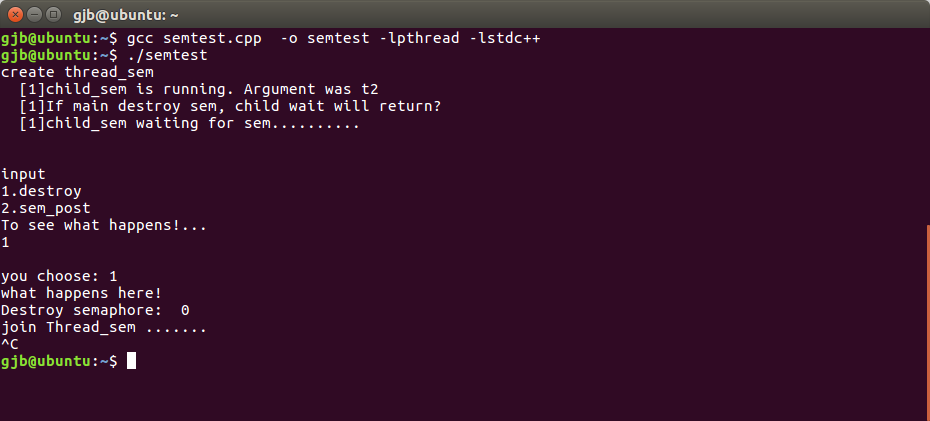Linux GCC 開發入門(4) -- pthread多執行緒 初步 semaphore
阿新 • • 發佈:2019-02-17
多執行緒 是 Linux 程式設計必備。程式設計介面上 自然是支援 最多的 POSIX pthread.
1.執行緒的產生: pthread_create 可以立刻執行一個 void * thread_func(void *) 的執行緒。
2.執行緒通訊: 互斥保護 pthread_mutex_t, 條件訊號 pthread_cond_t.
pthread_mutex_t 和widnows下的CRITICAL_SECTION 完全相同。
但是看文件 cond用起來 怪怪的。
a. cond 無論廣播 還是 單個觸發訊號, 都針對正在等待cond的執行緒有效。 如果觸發之後,執行緒再等待則無效。 (why?)
b. cond 等待 還要一個mutex 配合。 (不明白,其中的道理)
倒是 semaphore, 發現這個和widnows下的表現最一致。
測試程式
1. 子執行緒 等待 訊號量
2. 主執行緒 呼叫 sem_destroy 是否 會 使 等待的執行緒產生錯誤。
測試結果
LINUX下, 子執行緒不受sem_destroy 的影響。 一直處於等待狀態。
#include <iostream> #include <map> using namespace std; #include <semaphore.h> #include <sys/unistd.h> #include <pthread.h> #include <stdio.h> #include <stdlib.h> #include <string.h> #include <unistd.h> #include <mqueue.h> sem_t g_sem; const char * ret_msg[] = { "sem thread exit!", "cond thread exit!", "que thread exit!" }; const char * in_msg[] = { "t1", "t2", "t3"} ; void *thread_sem(void *arg) { int iwait ; sleep( 1 ); printf(" [1]child_sem is running. Argument was %s\n", (char *)arg ); printf(" [1]If main destroy sem, child wait will return? \n" ); printf(" [1]child_sem waiting for sem.......... \n" ); iwait = sem_wait( &g_sem ); if ( iwait == 0 ) { printf(" [1]child_sem waiting return OK! \n" ); } else { printf(" [1]child_sem waiting return error! %d\n", iwait ); } pthread_exit( (void *)ret_msg[0] ); } int main() { int res, ifunc, csel; pthread_t t1, t2, t3; void *thread_result; sem_init( &g_sem , 0, 0 ); printf("create thread_sem \n"); res = pthread_create(&t1, NULL, thread_sem, (void *)in_msg[1]); sleep( 2 ); printf("\n\ninput \n1.destroy\n2.sem_post \nTo see what happens!...\n"); do { csel = getchar(); }while( csel == '\n' ); printf("\nyou choose: %c\nwhat happens here!\n", csel ); if ( csel == '1') { ifunc = sem_destroy( &g_sem ); printf( "Destroy semaphore: %d\n", ifunc ); } else { ifunc = sem_post( &g_sem ); printf( "Post semaphore: %d\n", ifunc ); } printf("join Thread_sem .......\n"); res = pthread_join( t1, &thread_result); printf("Thread_sem joined, %d %s\n", res, (char *)thread_result); exit(EXIT_FAILURE); }
結果

